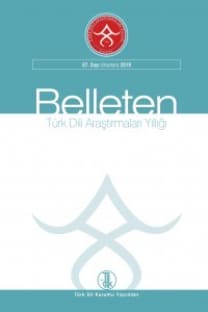HUÁ-YÍ-YÌ-YǓ’DAKİ UYGURCA MALZEME VE SORUNLARI
“Huá-yí-yì-yǔ” (華夷譯語), Míng (明) Hanedanı’nın (1368~1644) başlagıcından beri telif edilegelen Çince ve komşu dilleri arasındaki türlü lügatçelerin (ve tümce örneklerinin) genel bir adıdır. 2. ve 3. gruplardaki lügatçelerde Uygurca malzeme bulunmaktadır. 2. gruptaki lügatçelerin Çin harfli ve Uygur harfli olan nüshalar olmasına karşın 3. grupdaki lügatçeler ise sadece Çin harfli olan nüshalardır. 2. gruptaki lügatçelerde Uygurca sözcükler Uygur yazısı ile de yazıldığı için nispeten kolay tespit edilebilir ve okunabilir. 3. gruptaki lügatçelerde bulunan Uygurca malzemeyi işlemek için hem eski Uygurcadan hem de Çin yazısından anlamak gerekiyor.3. gruptaki lügatçelerde 15. yüzyıl Uygurcasının 820’den fazla sözcüğü bulunmaktadır. Böylece sadece Çin yazısıyla kaydedilmiş en zengin Türkçe malzeme konumundadır. Bu Uygurca malzemeyi işleyen sadece Masahiro Shōgaito ve YongSŏng Li’dir. Çok ayrıntılı bir çalışma yapmasına karşın Masahiro Shōgaito bazı sözcükleri ya yanlış okumuş ya da okuyamamıştır. Çin yazısında birbirine benzeyen harfler çok olduğu için elle istinsah edilirken yanlış aktarılan harfler az değildir, hatta Çince sözcüklerde bile böyledir. Buna göre, bir an önce mevcut olan 3. gruptaki bütün nüshaları ve kopyalarını bir araya getirerek herkesin kullanabileceği bir kitap halinde yayımlamak ve bütün nüshalara bakarak Uygurca sözcükleri doğru okumak gerekiyor
Anahtar Kelimeler:
Çin yazısı, “Huá-yí-yì-yǔ”, lügatçe, 15. yüzyıl, Türkçe, Uygurca
Uyghur Material in Huá-yí-yì-yǔ And Its Problems
The “Huá-yí-yì-yǔ” (華夷譯語) is a general name for the various glossaries (and sentence examples) between the Chinese language and its neighbor languages compiled on from the beginning of the Ming (明) dynasty (1368~1644). The Uyghur material is in the glossaries of the second and third classes. The glossaries of the second class are both in Chinese and in Uyghur characters, whereas the glossaries of the third class are only in Chinese characters. The words in the glossaries of the second class can be relatively easily determined and read. In order to treat the Uyghur material in the glossaries of the third class, one must understand both the old Uyghur language and Chinese characters well.In the glossaries of the third class, there are more than 820 words of the Uyghur language of the 15th century. Thus, it is in a state of the richest Turkic material recorded only in Chinese characters. This Uyghur material was treated only by Masahiro Shōgaito and Yong-Sŏng Li. Although Masahiro Shōgaito did research in minute detail, he misread or could not read some words. Not a few words were transmitted incorrectly during the duplication by hand because there are many similar letters in Chinese characters. It is so even in the Chinese words. Therefore, it is necessary to bring together all the existing copies and their duplicates and to publish them as a book which can be used by everebody, and to read the Uyghur words correctly by referring to all the copies
Keywords:
Chinese characteres, 15th century, glossary, “Huá-yí-yì-yǔ”, Turkic, Uyghur,
- ISSN: 0564-5050
- Başlangıç: 1953
- Yayıncı: Türk Dil Kurumu
